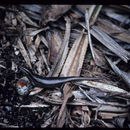Biology
(
Inglês
)
fornecido por Arkive
Wright's skink is a generalist scavenger and predator, largely dependent on seabird colonies where it feeds on insects attracted to dropped fish, and on the eggs and chicks of the birds (1) (4). It feeds heavily on these items, putting on much weight in the seabird breeding season. For the rest of the year it survives on declining insect populations. Its large size enables Wright's skink to store large fat reserves sufficient to survive several months until the seabirds return to their breeding colonies (4).
Little is known about the biology of Wright's skink, although we do know that this skink is an egg-laying species (1). Eggs of skinks are usually laid as single clutches, and may be guarded or abandoned, but in some species they are laid communally. Clutches are typically small in this lizard family, and limited to just one or two eggs in some species (3). Most skink species are diurnal, although some are nocturnal or crepuscular (3).
Conservation
(
Inglês
)
fornecido por Arkive
Wright's skink and the associated breeding seabird colonies are protected in the Aride, Cousin and Cousine Special Reserves (1).
Description
(
Inglês
)
fornecido por Arkive
Skinks (Scincidae) are typically small lizards with smooth, shiny scales and elongate, cylindrical bodies (2), not usually exceeding 12 centimetres in total length (3). In most species, the long, tapering tail is easily shed as a defence mechanism against predators, and can be regenerated (2) (3). Their heads are generally cone-shaped and somewhat flattened, with a long snout, though males of some species develop broad heads, which is thought to be an adaptation to aggressive competition during the breeding season (2) (3). The tongue is broad, has an arrowhead-shaped tip and is covered with serrated scales (3). Skinks are most frequently striped or otherwise patterned (2), but Wright's skink is more uniformly metallic brown in colour, darker above and paler below, with only faint longitudinal stripes.
Habitat
(
Inglês
)
fornecido por Arkive
Found on the ground and occasionally in trees in dry forest and shrubland (1).
Range
(
Inglês
)
fornecido por Arkive
Confined only to Seychelles islands with seabird colonies, including Aride, Cousin, Cousine, St. Pierre, Mammelles, Recifs and Frégate. Some historical records also exist from Bird Island, but this appears to have been a temporary introduction (1).
Status
(
Inglês
)
fornecido por Arkive
Classified as Vulnerable (VU) on the IUCN Red List (1).
Threats
(
Inglês
)
fornecido por Arkive
Although there are no direct threats to Wright's skink, the seabird colonies on which it depends are at risk from human disturbance. It is therefore highly vulnerable to the loss of any of these colonies (1).
Distribution
(
Inglês
)
fornecido por ReptileDB
Continent: Indian-Ocean
Distribution: Seychelles (Cousin)
Wright's skink
(
Inglês
)
fornecido por wikipedia EN
- licença
- cc-by-sa-3.0
- direitos autorais
- Wikipedia authors and editors
Wright's skink: Brief Summary
(
Inglês
)
fornecido por wikipedia EN
Wright's skink (Trachylepis wrightii), also known commonly as Wright's mabuya, is a species of lizard in the family Scincidae. The species is endemic to Seychelles. There are two recognized subspecies.
- licença
- cc-by-sa-3.0
- direitos autorais
- Wikipedia authors and editors

